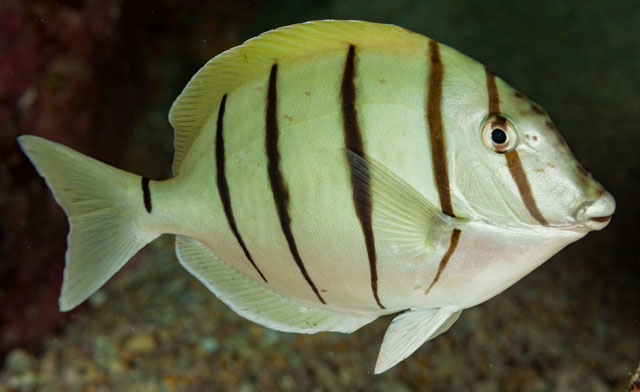| Acanthuridae (Surgeonfishes, tangs, unicornfishes), subfamily: Acanthurinae |
| 27 cm TL (male/unsexed) |
|
reef-associated; marine; depth range 0 - 90 m |
| Indo-Pacific: throughout the region except for the seas around the Arabian Peninsula. Eastern Pacific: lower Gulf of California to Panama, including the Revillagigedo, Cocos, Clipperton, and Galapagos islands. |
|
Dorsal spines (total): 9-9; Dorsal soft rays (total): 22-26; Anal spines: 3-3; Anal soft rays: 19-22. Body olivaceous gray, with 4 vertical stripes (1 stripe on head across the yellow eye; 1 on caudal peduncle); shading to white ventrally, often with a sharp line of demarcation. Sharp, forward-pointing, erectile spine on each side of caudal peduncle which folds down into a groove. Scales minute. Teeth with denticulations on sides and top. Gill rakers 18-22 in anterior row, 19-24 in posterior row.
Description: Characterized further by having small caudal spine; greatest depth of body 1.8-1.9 in SL (Ref. 90102). |
| Adults occur in lagoon and seaward reefs with hard substrate; young abundant in tide pools (Ref. 3145, 48637). Benthopelagic (Ref. 58302). Often feeding near freshwater run-offs where certain algae grow on rocks that are grazed (Ref. 48637). Occasionally form schools; feed on filamentous algae in large aggregations. During spawning, clouds of eggs and sperm are preyed upon by eagle rays which are often present during spawning. Form spawning aggregations (Ref. 27825). Size of metamorphosis from post-larva stage to juvenile is 3.2 cm (Ref. 9267). Utilized as a food fish (Ref. 7364). Minimum depth reported taken from Ref. 27115. |
|
Least Concern (LC); Date assessed: 04 May 2010 Ref. (130435)
|
| reports of ciguatera poisoning |
|
Known from the Kermadec Is. (Ref. 8879) and Norfolk Island (Ref. 45524). |
Source and more info: www.fishbase.org. For personal, classroom, and other internal use only. Not for publication.

